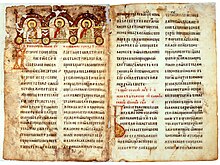Miroslav Gospel
| Miroslav's Gospel | |
|---|---|
 First two pages of the manuscript | |
| Created | 1186 |
| Location | National Museum of Serbia, Belgrade |
| Author(s) | Grigorije the Pupil |

Miroslav's Gospel (Template:Lang-sr / Miroslavljevo Jevanđelje, pronounced [mǐrɔslaʋʎɛʋɔ jɛʋǎndʑɛːʎɛ]) is a 362-page illuminated manuscript Gospel Book on parchment with very rich decorations. It is one of the oldest surviving documents written in Serbian recension of Church Slavonic.
It was created by order by Miroslav of Hum, brother of Stefan Nemanja, Grand Prince of Rascia. The first to discover and study the manuscript were three Russian scholars: Vladimir Stasov, Fyodor Buslayev, and Nikodim Kondakov. A leaf of the book which Archbishop Porfiry Uspensky cut out of the book from the Hilandar Monastery library in 1845 was first shown at the exhibition in Kiev in 1874.[1] The earliest facsimile edition appeared in Vienna in 1897. The book was traditionally preserved in the Hilandar Monastery on Mount Athos, before it was presented to king Alexander I Obrenovic of Serbia, on the occasion of his visit to the monastery in 1896. Today it is at the collection of the National Museum of Serbia in Belgrade.
The book was transcribed in Kotor (in today's Montenegro) between 1186 and 1190 from an earlier text. Most pages are by the unknown scribe from Zeta, with the last few pages being by the scribe Grigorije of Raška.
In 2005, the Miroslav Gospel was inscribed on UNESCO's Memory of the World Register in recognition of its historical value.[2]
See also
References
- ^ NLR.ru
- ^ "Miroslav Gospel – Manuscript from 1180". UNESCO Memory of the World Programme. 2014-01-19. Retrieved 2009-12-14.
Further reading
- Dušan Mrđenović; Veljko Topalović; Vera Radosavljević (2002). Miroslavljevo jevanđelje: istorijat i komentari. Dosije.
External links
- Medieval Serbia
- Medieval Serbian literature
- Serbian books
- Serbian manuscripts
- South Slavic manuscripts
- 12th-century biblical manuscripts
- 12th century in Serbia
- Gospel Books
- Memory of the World Register
- Medieval documents of Serbia
- World Digital Library
- 12th-century illuminated manuscripts
- Illuminated manuscript stubs

